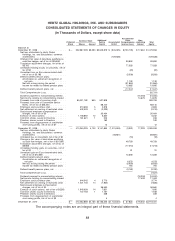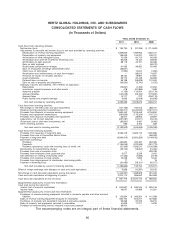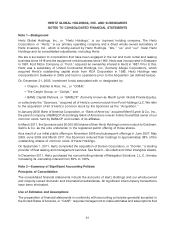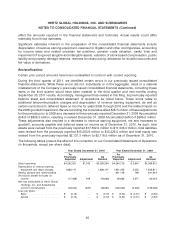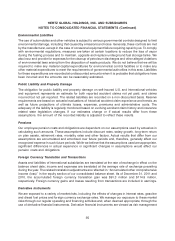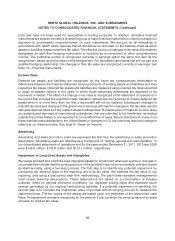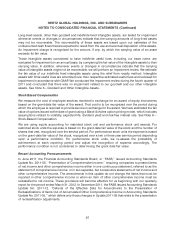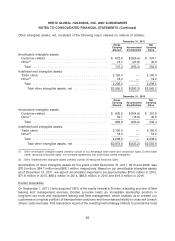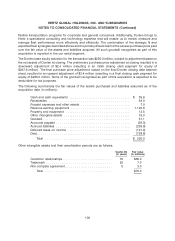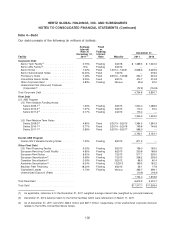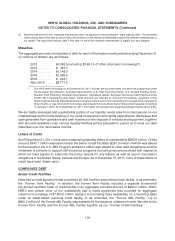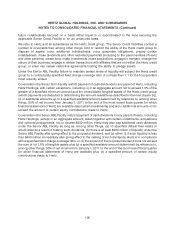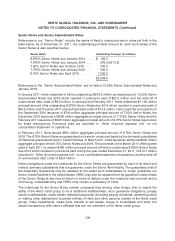Hertz 2011 Annual Report Download - page 123
Download and view the complete annual report
Please find page 123 of the 2011 Hertz annual report below. You can navigate through the pages in the report by either clicking on the pages listed below, or by using the keyword search tool below to find specific information within the annual report.HERTZ GLOBAL HOLDINGS, INC. AND SUBSIDIARIES
NOTES TO CONSOLIDATED FINANCIAL STATEMENTS (Continued)
Long-lived assets, other than goodwill and indefinite-lived intangible assets, are tested for impairment
whenever events or changes in circumstances indicate that the carrying amounts of long-lived assets
may not be recoverable. The recoverability of these assets are based upon our estimates of the
undiscounted cash flows that are expected to result from the use and eventual disposition of the assets.
An impairment charge is recognized for the amount, if any, by which the carrying value of an asset
exceeds its fair value.
Those intangible assets considered to have indefinite useful lives, including our trade name, are
evaluated for impairment on an annual basis, by comparing the fair value of the intangible assets to their
carrying value. In addition, whenever events or changes in circumstances indicate that the carrying
value of intangible assets might not be recoverable, we will perform an impairment review. We estimate
the fair value of our indefinite lived intangible assets using the relief from royalty method. Intangible
assets with finite useful lives are amortized over their respective estimated useful lives and reviewed for
impairment in accordance with GAAP. We conducted the impairment review during the fourth quarter of
2011 and concluded that there was no impairment related to our goodwill and our other intangible
assets. See Note 3—Goodwill and Other Intangible Assets.
Stock-Based Compensation
We measure the cost of employee services received in exchange for an award of equity instruments
based on the grant-date fair value of the award. That cost is to be recognized over the period during
which the employee is required to provide service in exchange for the award. We have estimated the fair
value of options issued at the date of grant using a Black-Scholes option-pricing model, which includes
assumptions related to volatility, expected life, dividend yield and risk-free interest rate. See Note 6—
Stock-Based Compensation.
We are using equity accounting for restricted stock unit and performance stock unit awards. For
restricted stock units the expense is based on the grant-date fair value of the stock and the number of
shares that vest, recognized over the service period. For performance stock units the expense is based
on the grant-date fair value of the stock, recognized over a two or three year service period depending
upon a performance condition. For performance stock units, we re-assess the probability of
achievement at each reporting period and adjust the recognition of expense accordingly. The
performance condition is not considered in determining the grant date fair value.
Recent Accounting Pronouncements
In June 2011, the Financial Accounting Standards Board, or ‘‘FASB,’’ issued Accounting Standards
Update No. 2011-05, ‘‘Presentation of Comprehensive Income,’’ requiring companies to present items
of net income and other comprehensive income either in one continuous statement, referred to as the
statement of comprehensive income, or in two separate, but consecutive statements of net income and
other comprehensive income. The amendments in this update do not change the items that must be
reported in other comprehensive income or when an item of other comprehensive income must be
reclassified to net income. These provisions will become effective for us beginning with our quarterly
report for the period ended March 31, 2012. In December 2011, the FASB issued Accounting Standards
Update No. 2011-12, ‘‘Deferral of the Effective Date for Amendments to the Presentation of
Reclassifications of Items Out of Accumulated Other Comprehensive Income in Accounting Standards
Update No. 2011-05,’’ which defers only those changes in Update 2011-05 that relate to the presentation
of reclassification adjustments.
97



